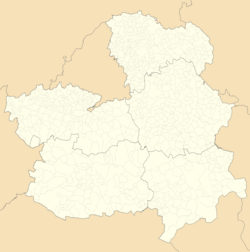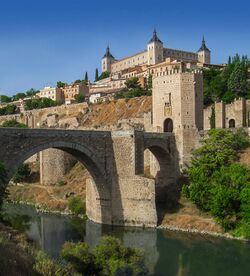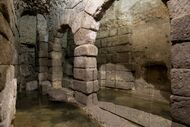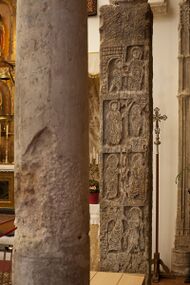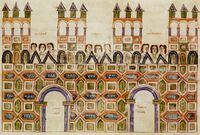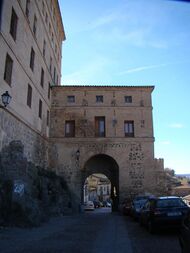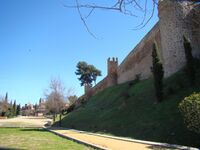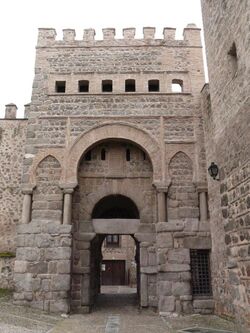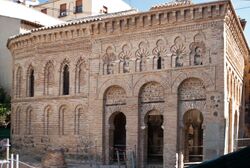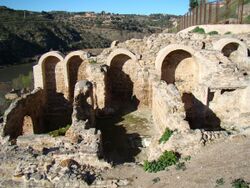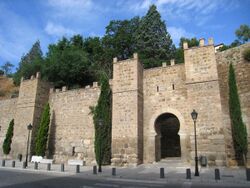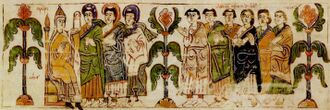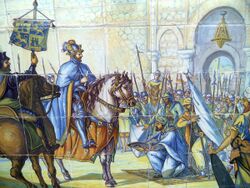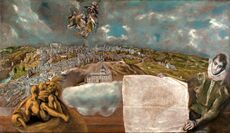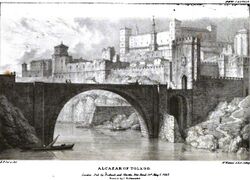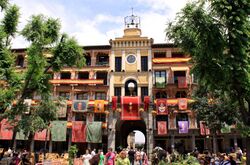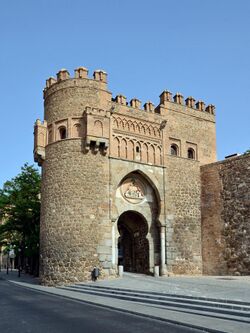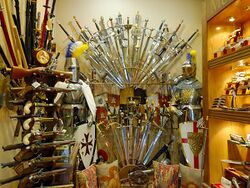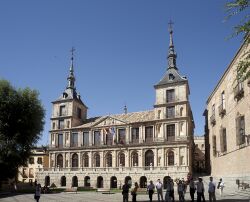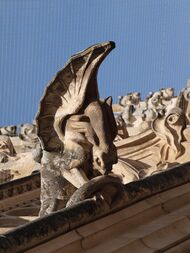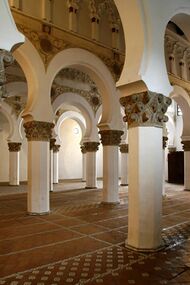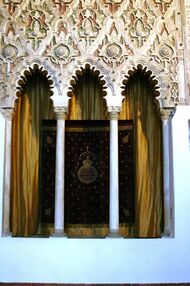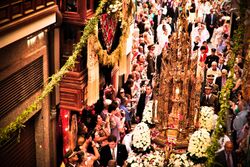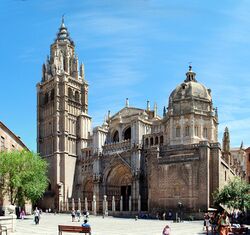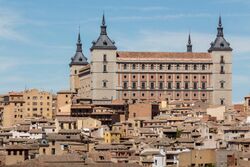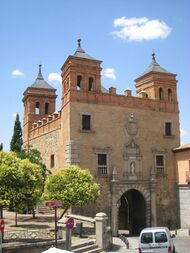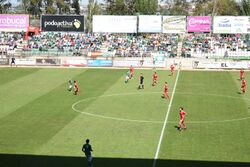Toledo, Spain
Topic: Place
 From HandWiki - Reading time: 40 min
From HandWiki - Reading time: 40 min
This article may contain an excessive amount of intricate detail that may interest only a particular audience. (July 2018) (Learn how and when to remove this template message) |
Toledo | |
|---|---|
City | |
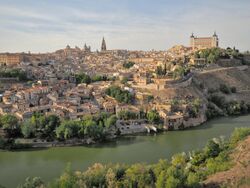 Toledo and the Tagus River | |
| Nickname(s): La ciudad Imperial (The Imperial City), Ciudad de las Tres Culturas (City of the Three Cultures) | |
| Coordinates: [ ⚑ ] : 39°51′24″N 4°1′28″W / 39.85667°N 4.02444°W | |
| Country | Spain |
| Autonomous Community | Castile–La Mancha |
| Province | Toledo |
| Comarca | Vega del Tajo |
| Partido judicial | Toledo |
| Settled | Pre-Roman |
| Government | |
| • Mayor | Milagros Tolón (PSOE) |
| Area | |
| • Land | 232.1 km2 (89.6 sq mi) |
| Elevation | 529 m (1,736 ft) |
| Population | |
| • Total | Template:Spain metadata Wikidata |
| • Density | 359.58/km2 (931.3/sq mi) |
| Postcode | 45001–45009 |
| Area code(s) | +34 |
| Website | toledo |
| UNESCO World Heritage Site | |
|---|---|
 | |
| Criteria | Cultural: i, ii, iii, iv |
| Reference | 379 |
| Inscription | 1986 (10th session) |
| Area | 259.85 ha |
| Buffer zone | 7,669.28 ha |
Toledo (UK: /tɒˈleɪdoʊ/, US: /toʊˈleɪðoʊ, -ˈlɛð-, təˈliːdoʊ/,[1][2][3] Spanish: [toˈleðo] (![]() listen)) is a city and municipality located in central Spain; it is the capital of the province of Toledo in the autonomous community of Castile–La Mancha. Toledo was declared a World Heritage Site by UNESCO in 1986 for its extensive monumental and cultural heritage.
listen)) is a city and municipality located in central Spain; it is the capital of the province of Toledo in the autonomous community of Castile–La Mancha. Toledo was declared a World Heritage Site by UNESCO in 1986 for its extensive monumental and cultural heritage.
Toledo is known as the "Imperial City" because it was the main venue of the court of Charles V, Holy Roman Emperor in Spain, and as the "City of the Three Cultures" for the cultural influences of Christians, Muslims and Jews reflected in its history. It was also the capital from 542 to 725 AD of the ancient Visigothic kingdom, which followed the fall of the Roman Empire, and the location of historic events such as the Visigothic Councils of Toledo. Toledo has a long history in the production of bladed weapons, which are now common souvenirs from the city.
People who were born or have lived in Toledo include Brunhilda of Austrasia, Al-Zarqali, Garcilaso de la Vega, Eleanor of Toledo, Alfonso X, Israeli ben Joseph, Halevi, and El Greco. (As of 2015), the city had a population of 83,226[4] and an area of 232.1 km2 (89.6 sq mi).
Coat of arms
The town was granted arms in the 16th century, which by special royal privilege was based on the royal of arms of Spain.
History
Antiquity
Toledo (Latin: Toletum) is mentioned by the Roman historian Livy (ca. 59 BC – 17 AD) as urbs parva, sed loco munita ("a small city, but fortified by location"). Roman general Marcus Fulvius Nobilior fought a battle near the city in 193 BC against a confederation of Celtic tribes including the Vaccaei, Vettones, and Celtiberi, defeating them and capturing a king called Hilermus.[5][6] At that time, Toletum was a city of the Carpetani tribe, and part of the region of Carpetania.[7] It was incorporated into the Roman Empire as a civitas stipendiaria, that is, a tributary city of non-citizens, and by Flavian times it had achieved the status of municipium.[8] With this status, city officials, even of Carpetani origin, obtained Roman citizenship for public service, and the forms of Roman law and politics were increasingly adopted.[9] At approximately this time, a Roman circus, city walls, public baths, and a municipal water supply and storage system were constructed in Toletum.[10]
The Roman circus in Toledo was one of the largest in Hispania, at 423 metres (1,388 feet) long and 100 metres (330 feet) wide, with a track dimension of 408 metres (1,339 feet) long and 86 metres (282 feet) wide.[10] Chariot races were held on special holidays and were also commissioned by private citizens to celebrate career achievements. A fragmentary stone inscription records circus games paid for by a citizen of unknown name to celebrate his achieving the sevirate, a kind of priesthood conferring high status. Archaeologists have also identified portions of a special seat of the sort used by the city elites to attend circus games, called a sella curulis. The circus could hold up to 15000 spectators.[10]
During Roman times, Toledo was never a provincial capital nor a conventus iuridicus,[11] but it started to gain importance in late antiquity. There are indications that large private houses (domus) within the city walls were enlarged, while several large villas were built north of the city through the third and fourth centuries.[12] Games were held in the circus into the late fourth and early fifth centuries C.E., also an indication of active city life and ongoing patronage by wealthy elites.[13] A church council was held in Toledo in the year 400 to discuss the conflict with Priscillianism.[14] A second council of Toledo was held in 527. The Visigothic king Theudis was in Toledo in 546, where he promulgated a law. This is strong though not certain evidence that Toledo was the chief residence for Theudis.[11] King Athanagild died in Toledo, probably in 568. Although Theudis and Athangild based themselves in Toledo, Toledo was not yet the capital city of the Iberian peninsula, as Theudis and Athangild's power was limited in extent, the Suevi ruling Galicia and local elites dominating Lusitania, Betica, and Cantabria.[15][16] This changed with Liuvigild (Leovigild), who brought the peninsula under his control. The Visigoths ruled from Toledo until the Moors conquered the Iberian peninsula in the early years of 8th century (711–719).
Today in the historic center basements, passages, wells, baths and ancient water pipes are preserved that since Roman times have been used in the city.
Visigothic Toledo
A series of church councils was held in Toledo under the Visigoths. A synod of Arian bishops was held in 580 to discuss theological reconciliation with Nicene Christianity.[17] Liuvigild's successor, Reccared, hosted the Third Council of Toledo, at which the Visigothic kings abandoned Arianism and reconciled with the existing Hispano-Roman episcopate.[18] A synod held in 610 transferred the metropolitanate of the old province of Carthaginensis from Cartagena to Toledo.[19] At that time, Cartagena was ruled by the Byzantines, and this move ensured a closer relation between the bishops of Spain and the Visigothic kings. King Sisebut forced Jews in the Visigothic kingdom to convert to Christianity; this act was criticized and efforts were made to reverse it at the Fourth Council of Toledo in 633.[20] The Fifth and Sixth Councils of Toledo placed church sanctions on anyone who would challenge the Visigothic kings.[21] The Seventh Council of Toledo instituted a requirement that all bishops in the area of a royal city, that is, of Toledo, must reside for one month per year in Toledo. This was a stage in "the elevation of Toledo as the primatial see of the whole church of the Visgothic kingdom".[22] In addition, the seventh council declared that any clergy fleeing the kingdom, assisting conspirators against the king, or aiding conspirators, would be excommunicated and no one should remove this sentence. The ban on lifing these sentences of excommunication was lifted at the Eighth Council of Toledo in 653, at which, for the first time, decisions were signed by palace officials as well as bishops.[23]
The eighth council of Toledo took measures that enhanced Toledo's significance as the center of royal power in the Iberian peninsula. The council declared that the election of a new king following the death of the old one should only take place in the royal city, or wherever the old king died.[24] In practice this handed the power to choose kings to only such palace officials and military commanders who were in regular attendance on the king. The decision also took king-making power away from the bishops, who would be in their own sees and would not have time to come together to attend the royal election. The decision did allow the bishop of Toledo, alone among bishops, to be involved in decisions concerning the royal Visigothic succession. The ninth and tenth councils were held in rapid succession in 655 and 656.[24]
When Reccesuinth died in 672 at his villa in Gerticos, his successor Wamba was elected on the spot, then went to Toledo to be anointed king by the bishop of Toledo, according to the procedures laid out in prior church councils.[25] In 673, Wamba defeated a rebel duke named Paul, and held his victory parade in Toledo. The parade included ritual humiliation and scalping of the defeated Paul.[26] Wamba carried out renovation works in Toledo in 674–675, marking these with inscriptions above the city gates that are no longer extant but were recorded in the eighth century.[27] The Eleventh Council of Toledo was held in 675 under king Wamba. Wamba weakened the power of the bishop of Toledo by creating a new bishopric outside Toledo at the church of Saints Peter and Paul. This was one of the main churches of Toledo and was the church where Wamba was anointed king, and the church from which Visigothic kings departed for war after special ceremonies in which they were presented with a relic of the True Cross. By creating a new bishopric there, Wamba removed power over royal succession from the bishop of Toledo and granted it to the new bishop.[28] The Twelfth Council of Toledo was held in 681 after Wamba's removal from office. Convinced that he was dying, Wamba had accepted a state of penitence that according to the decision of a previous church council, made him ineligible to remain king. The Twelfth Council, led by newly installed bishop Julian confirmed the validity of Wamba's removal from office and his succession by Ervig. The Twelfth Council eliminated the new bishopric that Wamba had created and returned the powers over succession to the bishop of Toledo.[29]
The Twelfth Council of Toledo approved 28 laws against the Jews. Julian of Toledo, despite a Jewish origin, was strongly anti-Semitic as reflected in his writings and activities.[30] The leading Jews of Toledo were assembled in the church of Saint Mary on January 27, 681, where the new laws were read out to them.
The Thirteenth, Fourteenth, and Fifteenth Councils of Toledo were held in 683, 684, and 688. The Thirteenth Council restored property and legal rights to those who had rebelled against King Wamba in 673.[31] The Thirteenth Council also approved laws protecting the king's family after the king's death. In 687, Ervig took the penitent state before dying, and the kingship passed to Egica, who was anointed king in Toledo on November 24.[32] In 688, the Fifteenth Council lifted the ban on taking property from the families of former kings, whereupon Egica was able to plunder Ervig's family properties.[33]
In the late seventh century, Toledo became a main center of literacy and writing in the Iberian peninsula. Toledo's development as a center of learning was influenced by Isidore of Seville, an author and advocate of literacy who attended several church councils in Toledo.[34] King Chindasuinth had a royal library in Toledo, and at least one count called Laurentius had a private library.[35] Sometime before 651, Chindasuinth sent the bishop of Zaragoza, Taio, to Rome to obtain books that were not available in Toledo. Taio obtained, at least, parts of pope Gregory's Moralia.[36] The library also contained a copy of a Hexameron by Dracontius, which Chindasuinth liked so much that he commissioned Eugenius II to revise it by adding a new part dealing with the seventh day of creation.[37] Chindasuinth issued laws that were gathered together in a book called Liber Iudiciorum by his successor Reccesuinth in 654; this book was revised twice, widely copied, and was an important influence on medieval Spanish law.[38] Three bishops of Toledo wrote works that were widely copied and disseminated in western Europe and parts of which survive to this day: Eugenius II, Ildefonsus, and Julian.[39] "In intellectual terms the leading Spanish churchmen of the seventh century had no equals before the appearance of Bede."[40]
In 693, the Sixteenth Council of Toledo condemned Sisebert, Julian's successor as bishop of Toledo, for having rebelled against King Egica in alliance with Liuvigoto, the widow of king Ervig.[41] A rebel king called Suniefred seized power in Toledo briefly at about this time. Whether or not Sisebert's and Suniefred's rebellions were the same or separate is unknown. Suniefred is known only from having minted coins in Toledo during what should have been Egica's reign.[42] The Seventeenth Council of Toledo was held in 694. The Eighteenth Council of Toledo, the last one, took place shortly after Egica's death around 702 or 703.[43]
By the end of the seventh century the bishop of Toledo was the leader of the Spanish bishops, a situation unusual in Europe: "The metropolitan bishops of Toledo had achieved by the last quarter of the seventh century an authority and a primacy that was unique in Western Europe. Not even the pope could count on such support from neighbouring metropolitans."[40] Toledo "had been matched by no other city in western Europe outside Italy as the governmental and symbolic center of a powerful monarchy".[44] Toledo had "emerged from relative obscurity to become the permanent governmental centre of the Visigothic monarchy; a true capital, whose only equivalent in western Europe was to be Lombard Pavia".[45]
When Wittiza died around 710, Ruderic became Visigothic king in Toledo, but the kingdom was split, as a rival king Achila ruled Tarraconensis and Narbonensis.[46] Meanwhile, Arabic and Berber troops under Musa ibn Nusayr had conquered Tangiers and Ceuta between 705 and 710, and commenced raids into the Visigothic kingdom in 711.[47] Ruderic led an army to confront the raiders. He was defeated and killed in battle, apparently after being betrayed by Visigothic nobles who wished to replace him as king and did not consider the Arabs and Berbers a serious threat. The commander of the invading forces was Tariq bin Ziyad, a Luwata Berber freedman in the service of governor Musa.[48] It is possible that a king called Oppa ruled in Toledo between Ruderic's death and the fall of Toledo.[49] Tariq, seizing the opportunity presented by the death of Ruderic and the internal divisions of the Visigothic nobles, captured Toledo, in 711 or 712.[50] Governor Musa disembarked in Cádiz and proceeded to Toledo, where he executed numerous Visigothic nobles, thus destroying much of the Visigothic power structure.[51][52] Collins suggests that the Visigothic emphasis on Toledo as the center of royal ceremony became a weakness. Since the king was chosen in or around Toledo, by nobles based in Toledo, and had to be anointed king by the bishop of Toledo in a church in Toledo, when Tariq captured Toledo and executed the Visigothic nobles, having already killed the king, there was no way for the Visigoths to select a legitimate king.[53][54]
Toledo under Moorish rule
Soon after the conquest, Musa and Tariq returned to Damascus. The Arab centre of administration was placed first in Seville, then moved to Córdoba. With most of the rest of the Iberian peninsula, Toledo was ruled from Córdoba by the governor of Al-Andalus, under the ultimate notional command of the Umayyad Caliph in Damascus. Arab conquerors had often replaced former capital cities with new ones to mark the change in political power, and they did so here: "Toledo suffered a period of profound decline throughout much of the earlier centuries of Arab dominance in the peninsula."[55] The invaders were ethnically diverse, and available evidence suggests that in the area of Toledo, Berber settlement predominated over Arab.[56]
In 742 the Berbers in Al-Andalus rebelled against the Arab Omeyyad governors. They took control of the north and marched south, laying siege to Toledo. After a siege of one month the Berber troops were defeated outside Toledo by troops sent from Cordoba by the governor Abd al-Malik ibn Katan and commanded by the governor's son.[57] However, while Ibn Katan's troops were engaged with the Berbers, his Arab allies betrayed and killed him and took over Cordoba. After the Arabs' first leader, Talama ibn Salama, died, Yusuf al-Fihri became ruler of Al-Andalus. The Omeyyad dynasty in Damascus collapsed and Yusuf ruled independently with the support of his Syrian Arab forces. The Qays Arab commander As-Sumayl was made governor of Toledo under Yusuf around 753.[58]
There is evidence that Toledo retained its importance as a literary and ecclesiastical centre into the middle 700s, in the Chronicle of 754, the life of Saint Ildefonsus by Cixila, and ecclesiastical letters sent from Toledo.[59] The eighth century bishop of Toledo, Cixila, wrote a life of Saint Ildefonsus of Toledo, probably before 737.[60] This life of Ildefonsus emphasised two episodes in the life of the bishop of Toledo. In the first episode the covering of the tomb of Saint Leocadia levitated while Ildefonsus was saying mass, with king Reccesuinth present. In the second episode Mary appears to Ildefonsus and Reccesuinth. These episodes are said to have resulted from Ildefonsus' devotion to Saint Leocadia, patroness saint of Toledo.[61] Collins suggests that Cixila's life of Ildefonsus helped maintain Ildefonsus' appeal and helped the church in Toledo to retain some of its authority among Christian churches in the Iberian peninsula.[62]
An archdeacon in Toledo called Evantius, who was active around 720 and died in 737, wrote a letter to address the existence of judaizing tendencies among the Christians of Zaragoza, specifically the belief that there are unclean forms of meat and the literal interpretation of Deuteronomic law.[63] A deacon and cantor from Toledo called Peter wrote a second letter, to Seville, in about the year 750, to explain that they were celebrating Easter and a September liturgical fast incorrectly, again confusing them with Jewish feasts celebrated at the same time.[64] These letters show that some of the primacy of the church of Toledo within the Iberian peninsula still existed in the 700s: "Not only were its clerics still well enough equipped in intellectual terms to provide authoritative guidance on a wide range of ecclesiastical discipline and doctrine, but this was also actively sought."[65]
There is a strong possibility that the Chronicle of 754 was written in Toledo (though scholars have also proposed Cordoba and Guadix) based on the information available to the chronicler.[66] The chronicler showed awareness of the Historia Gothorum, the Etymologiae, and the chronicle of Isidore of Seville, the work of Braulio of Zaragoza, the acts of the councils of Toledo, De Perpetua Virginitate by Ildefonsus, and De Comprobatione Sextae Aetatis and Historia Wambae by Julian of Toledo, all works that would have existed in the Visigothic libraries of seventh century Toledo and whose existence together "makes more sense in a Toledan context than in any other".[67]
In 756 Abd ar-Rahman, a descendant of the fallen Omeyyad caliphs, came to Al-Andalus and initiated a revolt against Yusuf. He defeated Yusuf and forced him to reside in Cordoba, but Yusuf broke the agreement and raised a Berber army to fight Abd ar-Rahman. In this conflict, Toledo was held against Abd ar-Rahman by Yusuf's cousin Hisham ibn Urwa. Yusuf attempted to march on Seville, but was defeated and instead attempted to reach his cousin in Toledo. He was either killed on his way to Toledo, or he reached Toledo and held out there for as many as two or three years before being betrayed and killed by his own people. Whether or not Yusuf himself held out in Toledo, Hisham ibn Urwa did hold power in Toledo for several years, resisting the authority of Abd ar-Rahman. In 761 Hisham is reported as again being in rebellion in Toledo against Abd ar-Rahman. Abd ar-Rahman failed to take Toledo by force and instead signed a treaty allowing Hisham to remain in control of Toledo, but giving one of his sons as hostage to Abd ar-Rahman. Hisham continued to defy Abd ar-Rahman, who had Hisham's son executed and the head catapulted over the city walls into Toledo. Abd ar-Rahman attacked Toledo in 764, winning only when some of Hisham's own people betrayed him and turned him over to Abd ar-Rahman and his freedman Badr.[68] Ibn al-Athir states that towards the end of Abd ar-Rahman's reign, a governor of Toledo raided in force into the Kingdom of Asturias during the reign of Mauregatus,[69] though the Asturian chronicles do not record the event.[70]
Under the Umayyad Emirate of Cordoba, Toledo was the centre of numerous insurrections dating from 761 to 857.[71] Twenty years after the rebellion of Hisham ibn Urwa, the last of Yusuf's sons, Abu al-Aswad ibn Yusuf, rebelled in Toledo in 785.[72][73] After the suppression of ibn Yusuf's revolt, Abd ar-Rahman's oldest son Sulayman was made governor of Toledo. However, Abd ar-Rahman designated as his successor a younger son, Hisham. On Hisham's accession to the Emirate in 788, Sulayman refused to make the oath of allegiance at the mosque, as succession custom would have dictated, and thus declared himself in rebellion. He was joined in Toledo by his brother Abdallah. Hisham laid siege to Toledo. While Abdallah held Toledo against Hisham, Sulayman escaped and attempted to find support elsewhere, but was unsuccessful. In 789, Abdallah submitted and Hisham took control of Toledo. The following year, Sulayman gave up the fight and went into exile.[74] Hisham's son Al-Hakam was governor of Toledo from 792 to 796 when he succeeded his father as emir in Cordoba.
After Al-Hakam's accession and departure, a poet resident in Toledo named Girbib ibn-Abdallah wrote verses against the Omeyyads, helping to inspire a revolt in Toledo against the new emir in 797. Chroniclers disagree as to the leader of this revolt, though Ibn Hayyan states that it was led by Ibn Hamir. Al-Hakam sent Amrus ibn Yusuf to fight the rebellion. Amrus took control of the Berber troops in Talavera. From there, Amrus negotiated with a faction inside Toledo called the Banu Mahsa, promising to make them governors if they would betray Ibn Hamir. The Banu Mahsa brought Ibn Hamir's head to Amrus at Talavera, but instead of making them governors, Amrus executed them. Amrus now persuaded the remaining factions in Toledo to submit to him. Once he entered Toledo, he invited the leaders to a celebratory feast. As they entered Amrus' fortress, the guests were beheaded one by one and their bodies thrown in a specially dug ditch. The massacre was thus called "The Day of the Ditch". Amrus' soldiers killed about 700 people that day. Amrus was governor of Toledo until 802.[75][76]
"In 785, Bishop Elipandus of Toledo wrote a letter condemning the teaching of a certain Migetius."[77] In his letter, Elipandus asserted that Christ had adopted his humanity, a position that came to be known as Adoptionism.[78] Two Asturian bishops, Beatus and Eterius, bishop of Osma, wrote a treatise condemning Elipandus' views.[79] Pope Hadrian wrote a letter between 785 and 791 in which he condemned Migetius, but also the terminology used by Elipandus.[80] The Frankish court of Charlemagne also condemned Adoptionism at the Synod of Frankfurt in 794.[81] Although Ramon Abadals y de Vinyals argued that this controversy represented an ideological assertion of independence by the Asturian church against the Moslem-ruled church of Toledo,[82] Collins believes this argument applies eleventh century ideology to the eighth century and is anachronistic.[83] However, Collins notes that the controversy and the alliances formed during it between Asturias and the Franks broke the old unity of the Spanish church.[84] The influence of the bishops of Toledo would be much more limited until the eleventh century.[85]
By the end of the 700s, the Omeyyads had created three frontier districts stretching out from the southern core of their Iberian territories. These were called the Lower March (al-Tagr al-Adna), Central March (al-Tagr al-Awsat), and Upper March (al-Tagr al-A'la). Toledo became the administrative center of the Central March, while Merida became the centre of the Lower March and Zaragoza of the Upper March.[86]
Following the death of Abd al-Rahman II, a new revolt broke out in Toledo. The Omeyyad governor was held hostage in order to secure the return of Toledan hostages held in Córdoba. Toledo now engaged in an inter-city feud with the nearby city of Calatrava la Vieja. Toledan soldiers attacked Calatrava, destroyed the walls, and massacred or expelled many inhabitants of Calatrava in 853. Soldiers from Cordoba came to restore the walls and protect Calatrava from Toledo. The new emir, Muhammad I, sent a second army to attack the Toledans, but was defeated. Toledo now made an alliance with King Ordoño I of Asturias. The Toledans and Asturians were defeated at the Battle of Guadacelete, with sources claiming 8000 Toledan and Asturian soldiers were killed and their heads sent back to Cordoba for display throughout Al-Andalus. Despite this defeat, Toledo did not surrender to Cordoba. The Omeyyads reinforced nearby fortresses with cavalry forces to try to contain the Toledans. Toledans attacked Talavera in 857, but were again defeated. In 858 emir Muhammad I personally led an expedition against Toledo and destroyed a bridge, but was unable to take the city. In 859, Muhammad I negotiated a truce with Toledo. Toledo became virtually independent for twenty years, though locked in conflict with neighboring cities. Muhammad I recovered control of Toledo in 873, when he successfully besieged the city and forced it to submit.[87]
The Banu Qasi gained nominal control of the city until 920 and in 932 Abd-ar-Rahman III captured the city following an extensive siege.[88] According to the Chronicle of Alfonso III, Musa ibn Musa of the Banu Qasi had, partly by war and partly by strategy, made himself master of Zaragoza, Tudela, Huesca, and Toledo. He had installed his son Lupus (Lubb) as governor of Toledo. King Ordoño I of Asturias fought a series of battles with Musa ibn Musa. According to the Chronicle, Musa ibn Musa allied with his brother-in-law Garcia, identified as Garcia Iñiquez, King of Pamplona. Ordoño defeated Musa's forces at the Battle of Monte Laturce. Musa died of injuries, and his son Lubb submitted to Ordoño's authority in 862 or 863, for the duration of Ordoño's reign (up to 866). Thus, according to the Chronicle of Alfonso III, Toledo was ruled by the Asturian kings. However, Arabic sources do not confirm these campaigns, instead stating that Musa ibn Musa was killed in a failed attack on Guadalajara, and that Andalusi forces repeatedly defeated Asturian forces in the area of Alava from 862 to 866.[89]
By the 870s the Omeyyads had regained control over Toledo. In 878 Al-Mundhir led an expedition against Asturias, of which one of the main components was a force from Toledo. One source portrays this raid as an attack by the 'King of Toledo', but other sources portray it as an Omeyyad raid involving substantial Toledan forces. The forces from Toledo were defeated by Alfonso III of Asturias at the Battle of Polvoraria. Spanish chronicles state that twelve to thirteen thousand in the Toledo army were killed in the battle. Collins states that these figures are "totally unreliable" but demonstrate that Asturian chroniclers thought of this as an important and decisive battle.[90]
In 920s and 930s, the governors of Toledo were in rebellion against the Umayyad regime in Cordoba, led by Abd al-Rahman III. In 930, Abd al-Rahman III, having now adopted the title of caliph, attacked Toledo.[91] The governor of Toledo asked for help from King Ramiro II of Leon, but Ramiro was preocuppied with a civil war against his brother Alfonso IV and was unable to help.[92] In 932, Abd al-Rahman III conquered Toledo, re-establishing control of al-Tagr al-Awsat, the Central March of the Omeyyad state.[93]
In 1009 one of the last Umayyad caliphs, Muhammad II al-Mahdi, fled to Toledo after being expelled from Cordoba by Berber forces backing the rival claimant Sulayman. Al-Mahdi and his Saqaliba general Wadih formed an alliance with the Count of Barcelona and his brother the Count of Urgell. These Catalans joined with Wadih and al-Mahdi in Toledo in 1010 and marched on Cordoba. The combination of Wadih's army and the Catalans defeated the Berbers in a battle outside Cordoba in 1010.[94]
After the fall of the Umayyad caliphate in the early 11th century, Toledo became an independent taifa kingdom. The population of Toledo at this time was about 28 thousand, including a Jewish population estimated at 4 thousand.[95] The Mozarab community had its own Christian bishop, and after the Christian conquest of Toledo, the city was a destination for Mozarab immigration from the Muslim south.[96] The taifa of Toledo was centered on the Tajo River. The border with the taifa of Badajoz was on the Tajo between Talavera de la Reina and Coria. North, the border was the Sierra de Guadarrama. Northeast, Toledo lands stretched past Guadalajara to Medinaceli. Southeast was the border with the taifa of Valencia, in La Mancha between Cuenca and Albacete. South were the borders with Badajoz around the Mountains of Toledo.[97]
In 1062, Fernando I of Leon and Castile attacked the taifa of Toledo. He conquered Talamanca de Jarama and besieged Alcala de Henares. To secure Fernando's withdrawal, king al-Mamun of Toledo agreed to pay an annual tribute, or parias, to Fernando.[98] Three years later in 1065, al-Mamun invaded the taifa of Valencia through La Mancha, successfully conquering it. Toledo controlled the taifa of Valencia until al-Mamun's death in 1075.[99]
After the death of Fernando I in 1065, the kingdom of Leon and Castilla was divided in three: the kingdoms of Galicia, Leon, and Castilla. The parias that had been paid by Toledo to Fernando I were assigned to the Kingdom of León, which was inherited by Alfonso VI.[100] However, in 1071, Alfonso's older brother Sancho II invaded Leon and defeated his younger brother. Alfonso VI was allowed to go into exile with al-Mamun in Toledo.[101] Alfonso VI was in exile in Toledo approximately from June to October 1071, but after Sancho II was killed later in the same year, Alfonso left Toledo and returned to Leon. Some sources state that al-Mamun forced Alfonso to swear support for al-Mamun and his heirs before allowing him to leave.[102]
In 1074, Alfonso VI campaigned against the taifa of Granada with the assistance of al-Mamun of Toledo. Alfonso received troops from al-Mamun in addition to the parias payment, facilitating his military campaigns. The campaign was successful, and Granada was forced to begin parias payments to Alfonso VI. After this, al-Mamun proceeded to attack Cordoba, which was then under the control of his enemy al-Mutamid, taifa king of Sevilla. He conquered Cordoba in January 1075.[103]
The parias of Toledo to Alfonso VI in the 1070s amounted to approximately 12 thousand gold dinars. This money contributed strongly to Alfonso VI's ability to project military strength throughout the Iberian peninsula.[104]
In 1076, al-Mamun of Toledo was killed in the city of Cordoba, which he had conquered only the year before. The taifa king of Sevilla took the opportunity to reconquer Cordoba and seize other territory on the borderlands between the taifas of Sevilla and Toledo. Al-Mamun was succeeded by his son, al-Qadir, the last taifa king of Toledo. Possibly keeping an earlier promise to al-Mamun, Alfonso VI at first supported the succession of al-Qadir. The taifa of Valencia, which had been conquered by al-Mamun, revolted against al-Qadir and ceased parias payments to Toledo.[105]
Taking advantage of al-Qadir's weakness, al-Mutamid of Sevilla took lands in La Mancha from the taifa of Toledo, and from there conquered the taifas of Valencia and Denia in 1078. After this, al-Qadir lost popularity in Toledo. There was a revolt against him, and he was forced to flee the city and appeal to Alfonso VI for help. The rebels invited the king of Badajoz, al-Mutawakkil, to rule Toledo. The king of Badajoz occupied Toledo in 1079, but Alfonso VI sent forces to help al-Qadir recover Toledo. Alfonso captured the fortress town of Coria, which controlled a pass from Castilian lands into the lands of the taifa of Badajoz. Since Alfonso now threatened him through Coria, al-Mutawakkil withdrew from Toledo and al-Qadir was able to return to Toledo. As the price of his help, Alfonso obtained the right to station two garrisons of his soldiers on the lands of Toledo, at al-Qadir's expense.[106]
A second revolt against al-Qadir took place in 1082. This time al-Qadir defeated the rebels in Toledo, chased them to Madrid, and defeated them there.[107] It was about this time at the latest that Alfonso VI decided to seize Toledo for himself, though some authors have argued that the plan to conquer Toledo existed by 1078.[108] In 1083, Alfonso VI campaigned against al-Mutamid, bringing his forces right up against Sevilla and reaching the city of Tarifa, with the intention of dissuading al-Mutamid from any resistance against the coming seizure of Toledo.[109] In 1084, Alfonso set siege to Toledo, preventing the city from being supplied and also preventing agricultural work in the area. Over the winter of 1084 to 1085 the siege was maintained, while the king spent the winter north in Leon and Sahagun. In spring 1085 Alfonso personally rejoined the siege with new forces. The city soon fell and Alfonso made his triumphant entry to the city on May 24, 1085.
Under Islamic Arab rule, Toledo was called Ṭulayṭulah. After the fall of the caliphate, Toledo was the capital city of one of the richest Taifas of Al-Andalus. Its population was overwhelmingly Muladi, and, because of its central location in the Iberian Peninsula, Toledo took a central position in the struggles between the Muslim and Christian rulers of northern Spain. The conquest of Toledo by Alfonso VI of Castile in 1085 marked the first time a major city in Al-Andalus was captured by Christian forces; it served to sharpen the religious aspect of the Christian reconquest.
Medieval Toledo after the Reconquista
On May 25, 1085, Alfonso VI of Castile took Toledo and established direct personal control over the Moorish city from which he had been exacting tribute, ending the medieval Taifa's Kingdom of Toledo. This was the first concrete step taken by the combined kingdom of Leon-Castile in the Reconquista by Christian forces. After Castilian conquest, Toledo continued to be a major cultural centre; its Arab libraries were not pillaged, and a tag-team translation centre was established in which books in Arabic or Hebrew would be translated into Castilian by Muslim and Jewish scholars, and from Castilian into Latin by Castilian scholars, thus letting long-lost knowledge spread through Christian Europe again. Toledo served as the capital city of Castile intermittently (Castile did not have a permanent capital) from 1085, and the city flourished. Under the Roman Catholic Archdiocese of Toledo multiple persecutions (633, 653, 693) and stake burnings of Jews (638 CE) occurred; the Kingdom of Toledo followed up on this tradition (1368, 1391, 1449, 1486–1490 CE) including forced conversions and mass murder and the rioting and blood bath against the Jews of Toledo (1212 CE).[110][111]
During the persecution of the Jews in the late 15th and early 16th centuries, members of the Jewish community of Toledo produced texts on their long history in Toledo. It was at this time that Don Isaac Abrabanel, a prominent Jewish figure in Spain in the 15th century and one of the king's trusted courtiers who witnessed the expulsion of Jews from Spain in 1492, wrote that Toledo was named Ṭulayṭulah by its first Jewish inhabitants who, he stated, settled there in the 5th century BCE, and which name – by way of conjecture – may have been related to its Hebrew cognate טלטול (= wandering), on account of their wandering from Jerusalem. He says, furthermore, that the original name of the city was Pirisvalle, so-called by its early pagan inhabitants.[112] However, there is no archaeological or historical evidence for Jewish presence in this region prior to the time of the Roman Empire; when the Romans first wrote about Toledo it was a Celtic city.[113][114]
| Historical population | ||
|---|---|---|
| Year | Pop. | ±% |
| 1991 | 59,000 | — |
| 1996 | 66,006 | +11.9% |
| 2001 | 68,382 | +3.6% |
| 2004 | 73,485 | +7.5% |
| 2006 | 77,601 | +5.6% |
Modern era
Charles I of Spain's court was set in Toledo, serving as the imperial capital.[115] In 1560, Toledo reached a population of 60,000, being the 3rd city of the Crown of Castile. However, in 1561, in the first years of his son Philip II of Spain's reign, the Spanish court was moved to Valladolid, thus letting the city's importance dwindle until the late 20th century, when it became the capital of the autonomous community of Castile–La Mancha. Nevertheless, the economic decline of the city helped to preserve its cultural and architectural heritage. Today, because of this rich heritage, Toledo is one of Spain's foremost cities, receiving thousands of visitors yearly.
Toledo's Alcázar (Latinized Arabic word for palace-castle, from the Arabic القصر, al-qasr) became renowned in the 19th and 20th centuries as a military academy. At the outbreak of the Spanish Civil War in 1936, its garrison was famously besieged by Republican forces.
Climate
Toledo has a typical cold semi-arid climate (Köppen: BSk). Winters are cool while summers are hot and dry. Precipitation is low and mainly concentrated in the period mid autumn through to mid spring. The highest temperature ever recorded in Toledo was 43.1 °C or 109.58 °F on 10 August 2012; the lowest was −9.1 °C or 15.6 °F on 27 January 2005. Script error: No such module "weather box".
Economy
The metal-working industry has historically been Toledo's economic base, with a great tradition in the manufacturing of swords and knives and a significant production of razor blades, medical devices and electrical products. (The Toledo Blade, the American newspaper in Toledo's Ohio namesake city, is named in honor of the sword-making tradition.) Soap and toothpaste industries, flour milling, glass and ceramics have also been important.[117] Goya Foods has its Madrid offices in Toledo.[118]
The manufacture of swords in the city of Toledo goes back to Roman times, but it was under Moorish rule and during the Reconquista that Toledo and its guild of sword-makers played a key role. Between the 15th and 17th centuries the Toledo sword-making industry enjoyed a great boom, to the point where its products came to be regarded as the best in Europe. Swords and daggers were made by individual craftsmen, although the sword-makers guild oversaw their quality. In the late 17th and early 18th century production began to decline, prompting the creation of the Royal Arms Factory in 1761 by order of King Carlos III. The Royal Factory brought together all the sword-makers guilds of the city and it was located in the former mint. In 1777, recognizing the need to expand the space, Carlos III commissioned the architect Sabatini to construct a new building on the outskirts of the city. This was the beginning of several phases of expansion. Its importance was such that it eventually developed into a city within the city of Toledo.
In the 20th century, the production of knives and swords for the army was reduced to cavalry weapons only, and after the Spanish Civil War, to the supply of swords to the officers and NCOs of the various military units. Following the closure of the factory in the 1980s, the building was renovated to house the campus of the Technological University of Castilla-La Mancha in Toledo.[119] According to the Statistical Institute of Castilla-La Mancha, in 2007 the recent distribution of employment by sectors of occupation was as follows: 86.5% of the population engaged in the services, 6.6% in construction, 5.4% in industry and 1.5% in agriculture and livestock.[120]
Unemployment
In the decade to 2008, unemployment in absolute terms remained fairly stable in the city of Toledo, but in 2009 this figure increased significantly: nearly 62% compared to 2008, with the number of unemployed rising from 2,515 to 4,074 (figures at 31 March each year), according to the Junta de Comunidades de Castilla La Mancha.[121] Of this 62%, one third of the increase took place in the first quarter.
According to other statistics from the same source, almost half the unemployed in the city of Toledo (1,970 persons) are among those whose education does not go beyond the compulsory secondary level. However, there are groups whose level of studies is such that they have not been registered as unemployed, such as those who have completed class 1 professional training, or those with virtually nonexistent unemployment rates (less than 0.1%), which is the case of unemployed with high school degrees or professional expertise.
The largest group among the unemployed is those who have no qualifications (27.27%).
Politics
Toledo has a 25-member City Council, elected by closed lists every four years. The 2011 election saw a pact made between the 11 members of the Spanish Socialist Workers' Party (PSOE) and the 2 members of the United Left, to retain the position of the PSOE's Emiliano García-Page Sánchez as mayor, which he has been since 2007.
Culture
The old city is located on a mountaintop with a 150-degree view, surrounded on three sides by a bend in the Tagus River, and contains many historical sites, including the Alcázar, the cathedral (the primate church of Spain), and the Zocodover, a central market place.
From the 4th century to the 16th century about thirty synods were held at Toledo. The earliest, directed against Priscillian, assembled in 400. At the synod of 589 the Visigothic King Reccared declared his conversion from Arianism to Catholicism; the synod of 633 decreed uniformity of catholic liturgy throughout the Visigothic kingdom and took stringent measures against baptized Jews who had relapsed into their former faith. Other councils forbade circumcision, Jewish rites and observance of the Sabbath and festivals. Throughout the seventh century, Jews were flogged, executed, had their property confiscated, were subjected to ruinous taxes, forbidden to trade and, at times, dragged to the baptismal font.[122] The council of 681 assured to the archbishop of Toledo the primacy of Spain. At Guadamur, very close to Toledo, was dug in 1858 the Treasure of Guarrazar, the best example of Visigothic art in Spain.
As nearly one hundred early canons of Toledo found a place in the Decretum Gratiani, they exerted an important influence on the development of ecclesiastical law. The synod of 1565–1566 concerned itself with the execution of the decrees of the Council of Trent; and the last council held at Toledo, 1582–1583, was guided in detail by Philip II.
Toledo had large communities of Muslims and Jews until they were expelled from Spain in 1492 (Jews) and 1502 (Mudéjars). Today's city contains the religious monuments the Synagogue of Santa María la Blanca, the Synagogue of El Transito, Mosque of Cristo de la Luz and the church of San Sebastián dating from before the expulsion, still maintained in good condition. Among Ladino-speaking Sephardi Jews, in their various diasporas, the family name Toledano is still prevalent – indicating an ancestry traced back to this city (the name is also attested among non-Jews in various Spanish-speaking countries).
In the 13th century, Toledo was a major cultural centre under the guidance of Alfonso X, called "El Sabio" ("the Wise") for his love of learning. The Toledo School of Translators, that had commenced under Archbishop Raymond of Toledo, continued to bring vast stores of knowledge to Europe by rendering great academic and philosophical works in Arabic into Latin. The Palacio de Galiana, built in the Mudéjar style, is one of the monuments that remain from that period.
The Cathedral of Toledo (Catedral de Toledo) was built between 1226 and 1493 and modeled after the Bourges Cathedral, though it also combines some characteristics of the Mudéjar style. It is remarkable for its incorporation of light and features the Baroque altar called El Transparente, several stories high, with fantastic figures of stucco, paintings, bronze castings, and multiple colors of marble, a masterpiece of medieval mixed media by Narciso Tomé topped by the daily effect for just a few minutes of a shaft of light from which this feature of the cathedral derives its name. Two notable bridges secured access to Toledo across the Tajo, the Alcántara bridge and the later built San Martín bridge.
The Monasterio de San Juan de los Reyes is a Franciscan monastery, built 1477–1504, in a remarkable combination of Gothic-Spanish-Flemish style with Mudéjar ornamentation.
Toledo was home to El Greco for the latter part of his life, and is the subject of some of his most famous paintings, including The Burial of the Count of Orgaz, exhibited in the Church of Santo Tomé.
When Philip II moved the royal court from Toledo to Madrid in 1561, the old city went into a slow decline from which it never recovered.
Toledo steel
Toledo has been a traditional sword-making, steel-working centre since about 500 BC, and came to the attention of Rome when used by Hannibal in the Punic Wars. Soon, it became a standard source of weaponry for Roman legions.[123]
Toledo steel was famed for its very high quality alloy,[124] whereas Damascene steel, a competitor from the Middle Ages on, was famed for a specific metal-working technique.[125]
Today there is a significant trade, and many shops offer all kinds of swords to their customers, whether historical or modern films swords, as well as medieval armors and from other times, which are also exported to other countries.
Gastronomy
Toledo's cuisine is grouped with that of Castile–La Mancha, well-set in its traditions and closely linked to hunting and grazing. A good number of recipes are the result of a combination of Moorish and Christian influences.
Some of its specialties include lamb roast or stew, cochifrito, alubias con perdiz (beans with partridge) and perdiz estofoda (partridge stew), carcamusa, migas, gachas manchegas, and tortilla a la magra. Two of the city's most famous food productions are Manchego cheese and marzipan, which has a Protected Geographical Indication (mazapán de Toledo).[126][127]
Holidays
- Virgen del Valle: This pilgrimage is celebrated on May 1 at the Ermita de la Virgen del Valle, with a concentration popular holiday in that place.
- Holy Week: Declared of National Tourist Interest, is held in spring with various processions, highlighting those that take place on Good Friday, and religious and cultural events. Since the Civil War, most of the steps were burned or destroyed, so it had to create new steps or using images from other churches and convents Toledo. Many people take advantage of the Easter break to visit the monastery churches that are only open to the general public at this time of year.[citation needed]
- Corpus Christi: Feast declared International Tourist Interest. Its origins lie in the thirteenth century. The processional cortege travels around two kilometres (1.2 miles) of streets and richly decorated awnings. In recent years, following the transfer of the traditional holiday Thursday present Sunday, was chosen to conduct two processions, one each of these days, with certain differences in members and protocol between them. [43]
- Virgen del Sagrario: On August 15 they celebrate the festival in honor of the Virgen del Sagrario. Procession is held inside the Cathedral and drinking water of the Virgin in jars.
Apart from these festivals should be noted that patrons of Toledo are:
- San Ildefonso, Toledo Visigoth bishop whose feast day is January 23.
- Santa Leocadia, virgin and martyr of Roman Hispania, which falls on December 9.
Main sights
The city of Toledo was declared a Historic-Artistic Site in 1940, UNESCO later given the title of World Heritage in 1987. Sights include:
- Tomb of Saint Beatrice of Silva, founder of the Order of the Immaculate Conception, at the Conceptionist Monastery of Toledo.
- Castillo de San Servando, medieval castle near the banks of the Tagus river and the Infantry Academy.
- The Gothic Cathedral, dating from the thirteenth century. Inside there is the Clear from Narciso Tome, in Baroque.
- Monasterio de San Juan de los Reyes, in Isabelline Gothic style (15th century).
- The Renaissance Museo-Hospital de Santa Cruz (16th century).
- El Greco Museum, a house-museum designed as a recreation of the artist's home, which was lost centuries ago. It houses several important paintings.
- Santa María la Blanca, the oldest synagogue building in Europe still standing, now owned by the Catholic Church.
- Synagogue of El Transito, in the Jewish Quarter. It is home to the Sephardic Museum.
- Hospital de Tavera Museum Duque de Lerma. Renaissance style, dates from the sixteenth century. Influenced the layout of El Escorial.
- Church of Santiago del Arrabal, in Mudéjar style.
- Iglesia de Santo Tome. Mudéjar style, the fourteenth century, houses the famous Burial of Count Orgaz, by El Greco.
- El Cristo de la Luz, a small mosque-oratory built in 999, later extended with Mudéjar apse for conversion into a church.
- Galiana Palace (13th century), in Mudéjar style.
- Tornerías Mosque (11th century).
- Alcazar fortress (16th century), located in the highest part of town, overlooking the city. From 2009 it houses the collection of the Army Museum.
- Iglesia de San Andrés, In its crypt are 60 mummies of infantes, dukes, nuns and others, in a good state of preservation, open to visitors.
- Puerta Bab al-Mardum (10th century), the oldest city gate of Toledo.
- Puerta de Bisagra Antigua (10th century), the main entrance to the city in Andalusian times. Also known as "Puerta de Alfonso VI".
- Puerta del Sol (14th century), built by the Knights Hospitallers.
- Puerta de Bisagra Nueva (16th century), of Moorish origin re-built by Alonso de Covarrubias. The main entrance and face of Toledo today.
- Puerta del Cambrón, of Muslim origin, re-built in the 16th century.
- San Román (Museum of the Councils and Visigoth culture).
- Ermita del Cristo de la Vega, in Mudéjar style (11th century).
- Alcántara bridge, Roman bridge across the Tagus.
- Puente de San Martin, medieval bridge across the Tagus.
To mark the fourth centenary of the publication of the first part of Don Quixote, the Council of Communities of Castile–La Mancha designed a series of routes through the region crossing the various points cited in the novel. Known as the Route of Don Quixote, two of the pathways designated, sections 1 and 8, are based in Toledo; those linking the city with La Mancha Castile and Montes de Toledo exploit the natural route which passes through the Cigarrales and heads to Cobisa, Nambroca Burguillos of Toledo, where it takes the Camino Real from Sevilla to suddenly turn towards Mascaraque Almonacid de Toledo, deep into their surroundings, near Mora, in La Mancha.
This stretch, Mascaraque-Toledo, of the Route of Don Quixote has recently been included in an official way on the Camino de Santiago in Levantine branch with origins in Cartagena, Alicante and Valencia, as both routes are declared a European Cultural Route on this stretch.
Infrastructure
Toledo has long been an obligatory stop in the centre of the peninsula. The roads leading to historic Toledo are still used and in many cases have provided the basis to existing roads leading into the city.
Roads
From Toledo part of N-400, which links this city with Cuenca by Ocaña and Tarancón. It is currently in the process of transformation in the future A-40 motorway Castilla La Mancha, which will link Maqueda (where it joins the motorway Extremadura), Toledo, Ocaña (where it attaches to the Motorway of Andalusia), Tarancón (where connects with the motorway Levante), Cuenca and Teruel.
The old National Road 401 Madrid-Toledo-Ciudad Real was transformed in the late 1980s in the current A-42 as a result of splitting and deleting the path that the various crossings counted (Illescas, Yuncos, etc.. ).
The split path can take 7 kilometres (4 miles) south of Toledo, in effect Ciudad Real, where it continues as conventional road. At this point, the A-42 connects with the Highway of the Vineyard that reaches Tomelloso. It is planned to extend the A-42, by a toll road, to Ciudad Real and Jaén.
In the early twenty-first century was built, in order to decongest the access of Madrid, the toll motorway AP-41.
Another way of State Highway Network that Toledo is part of the N-403, Toledo-Maqueda – Ávila – Adanero. Part of the route of this road will be replaced by that of the aforementioned Highway of Castilla La Mancha.
In addition to these roads, from Toledo depart several regional and provincial-level linking the capital with the regions of Montes de Toledo, La Jara and La Mancha.
Rail
In the mid-nineteenth century Toledo was one of the first Spanish cities to receive rail service, being attached to the Madrid – Aranjuez line which was inaugurated by Isabella II on June 12 of 1858. The current station, the Toledo Railway Station (built in Neo-Mudéjar style), was inaugurated on April 24 of 1919.
With several ups and downs in terms of technical equipment and services this is the line that served the city until the early twenty-first century: on July 2 of 2003 the last conventional train service between the two capitals ended and work began on the high-speed link, Madrid – Toledo, which entered service on November 16 of 2005, thanks to which travel time to Madrid has been reduced to just under 30 minutes.
Health
In the early 1960s began the construction of the Residence Health Social Security "Virgen de la Salud". The original building still remains in use, although successive extensions were added (maternity, outpatient clinics, operating rooms, etc.) into the existing complex. The complex was also extended to move the clinic to a new nearby building, now converted into Specialty Centre San Ildefonso.
The National Hospital for Paraplegics (es), inaugurated on 7 October 1974, became a centre of reference at the national level in the treatment of spinal cord injuries.[128] It also focuses on the social integration of their patients.
The transfer of powers from the state health at the Junta de Comunidades de Castilla La Mancha will give new impetus to the health infrastructure, manifested in 2007 with the commencement of construction of the new General Hospital of Toledo in the Santa Mary Benquerencia. Also have been provided to the different parts of the relevant health centres.
In the Toledo Hospital Complex [36] is also integrated Geriatric Hospital Virgen del Valle, a result of reform and modernization of old tuberculosis hospital built in the mid twentieth century. The centre is located outside the city, near the Parador Nacional de Turismo Conde de Orgaz.
With regard to private health, at present the city of Toledo has several centres: Hospital de las Tres Culturas, Clínica Nuestra Señora del Rosario, and so on.
Sport
Toledo suffered from a shortage of sports facilities.[citation needed] Much of this problem was resolved when the Central School of Physical Education of the Army moved its headquarters to the premises of the Academy of Infantry. In the 1990s, the city council took over the old facilities of the military centre, which now include an athletics track, Olympic swimming pool and an indoor sports hall, from the former military installations, and numerous outdoor courts built in the area of the former runway of application, having been demolished and the old gym complex pools (indoor and outdoor).
Besides these facilities, the city of Toledo has covered sports pavilions in the districts of Santa Maria de Benquerencia, Santa Barbara, San Anton (Complejo Deportivo "Leaping Horse"), outdoor pools in sugar, Palomarejos, Santa Maria de Benquerencia, Santa Barbara, Santa Teresa and indoor swimming pools in the gardens of the Alcazar (old town), Santa Maria de Benquerencia and San Antonio.[citation needed]
Toledo has a football team, CD Toledo, founded on 24 April 1928.[129] Their home turf is the Estadio Salto del Caballo, inaugurated on 23 November 1973.[130] The team played for 7 seasons in the Segunda División, during which it reached the play-off final for promotion to La Liga at the end of the 1993–94 season, losing 4–1 on aggregate to Real Valladolid. Toledo players have included Abel Resino, Luis Garcia, Arsenal coach Unai Emery, Rufete and Casquero.
Toledo also has teams of handball.[citation needed] The Toledo Handball, after five years in the Division de Honor B, start the 2009–2010 season as ASOBAL new club for the first time in its history. A refurbished town hall "Javier Lozano Cid ', with capacity for around 1,500 spectators, is its new headquarters. Moreover, the city has two other Division II team in the National, the Toledo Handball Lábaro-B and Club Deportivo Amibal.
Toledo has two basketball teams: the CIS Toledo, with a long history that has gone through ups and downs in both regional and in national leagues (EBA) and has just[when?] promoted to 1st Autonomic, and CB Polígono, currently the most representative, whose team has promoted male, seven years after leaving, to EBA League to start the 2009/10 season.[citation needed] This club based in the Santa Maria de Benquerencia district and has one of the largest quarries of Castilla-La Mancha.
Toledo has been represented in athletics since 2 April 1979 by the Toledo Athletic Club, that is characterised by its actions, mainly in cross-country, where he managed a large number of medals in the championships team Spain's specialty, in addition to their combined male and female military in the late 1990s in the 1st division league national track. Among the athletes who have passed through its lanes are great athletes as Julio Rey, Roberto Parra, Chema Martinez and Julia Lobato.
Cycling, meanwhile, after the victory in the Tour de France in 1959 by Federico Bahamontes, 'The Eagle of Toledo', has been one of the sports with more followers in the city, although, at present,[when?] no school despite having a velodrome in Santa María de Benquerencia.[citation needed] Other leading professional cyclists from the city have been Nemesio Jiménez (Mexico Olympics 1968) and Ángel de las Heras.
The FS and Volleyball Toledo Toledo Association Toledo complete representation in the National League of First and Second Division, after a brief journey in Fantasy, respectively, while the Toledo Rugby Club, with manyfans, is immersed in the League Madrid's Primera Liga.[citation needed]
At the individual level, the swimmer Javier Noriega and Julio Rey marathon athletes are more representative of the city, both in Athens Olympics 2004 and Beijing Olympics 2008, in recent years. Rey, Spanish current marathon record holder, with 2h.06:52, announced his retirement in October 2009.[citation needed]
Media
Various local and provincial newspapers are published in the city. In addition, national newspapers such as the daily ABC publish unique local editions.[citation needed] Among the local newspapers are the subscription-based La Tribuna de Toledo, and Toledo Day, as well as the free Global Castilla la Mancha and Toledo News. The general information weekly magazines Echoes and Here are also published.
There is also local media in television, radio and Internet. The regional public television headquarters, CMT, are in Toledo.[citation needed] In addition, there are several local television stations, as well as local fare: the diocesan Popular TV, Teletoledo, Canal Regional de Noticia and La Tribuna TV.
For radio stations, there is the dean of radio Radio Toledo (Onda Cero), as well as COPE, Cadena SER, RNE, RCM and Radio Aquí, and the local fare Onda Polígono and the diocesan station Radio Santa Maria. Within the digital and social media, Onda Toledo, Toledo Magic, Toledo Digital, and La Cerca.[citation needed]
International relations
Twin towns - sister cities
Toledo is twinned with:[131]
 Aachen, Germany (1984)
Aachen, Germany (1984) Agen, France (1973)
Agen, France (1973) Corpus Christi, United States (1989)
Corpus Christi, United States (1989) Damascus, Syria (1994)
Damascus, Syria (1994) Guanajuato City, Mexico (1978)
Guanajuato City, Mexico (1978) Heraklion, Greece (2014)
Heraklion, Greece (2014) Nara, Japan (1972)
Nara, Japan (1972) Old Havana, Cuba (2005)
Old Havana, Cuba (2005) Safed, Israel (1981)
Safed, Israel (1981) Toledo, United States (1931)
Toledo, United States (1931) Veliko Tarnovo, Bulgaria (1983)
Veliko Tarnovo, Bulgaria (1983)
See also
- Golden age of Jewish culture in Spain
- Councils of Toledo
- Toledo School of Translators
- Toledo steel
- Iglesia de San Andrés, Toledo
- Palacio de Galiana
- Cerro del Bu
- History of Toledo, Spain
- Artificio de Juanelo
- List of people from Toledo, Spain
References
- Informational notes
- Citations
- ↑ "Toledo". Boston: Houghton Mifflin Harcourt. 2014. https://www.ahdictionary.com/word/search.html?q=Toledo.
- ↑ "Toledo". Collins English Dictionary. HarperCollins. https://www.collinsdictionary.com/amp/english/toledo. Retrieved 14 April 2019.
- ↑ "Toledo". Merriam-Webster Dictionary. https://www.merriam-webster.com/dictionary/Toledo. Retrieved 14 April 2019.
- ↑ "Tabla2902". http://www.ine.es/jaxiT3/Datos.htm?t=2902.
- ↑ John S. Richardson (1996). The Romans in Spain. Blackwell. p. 54.
- ↑ Livy, History of Rome, 35, 22
- ↑ Rubio Rivera, Rebeca. Continuidad y cambio en el proceso de romanización del ámbito celtibérico meridional y carpetano. https://www.academia.edu/2085388. Retrieved 7 November 2015.
- ↑ Tsiolis, Vassilis. El primer recinto amurallado de Toledo. https://www.academia.edu/11311342. Retrieved 7 November 2015.
- ↑ Kulikowski, Michael (2004). Late Roman Spain and Its Cities. Baltimore: Johns Hopkins University Press.
- ↑ 10.0 10.1 10.2 Rubio Rivera, Rebeca. "El circo romano de Toledo y la Vega Baja en época romana". https://www.scribd.com/doc/265093313/Art-Circo-Romano-Rebeca-Rubio-1. Retrieved 24 November 2015.
- ↑ 11.0 11.1 Kulikowski, Michael (2004). Late Roman Spain and Its Cities. Johns Hopkins University Press. p. 265.
- ↑ Rubio Rivera, Rebeca (2001). El Circo Romano de Toledo y la Vega Baja en Época Romana. p. 51. https://www.scribd.com/doc/265093313/Art-Circo-Romano-Rebeca-Rubio-1. Retrieved 25 November 2015.
- ↑ Rubio Rivera, Rebeca (2001). El Circo Romano de Toledo y la Vega Baja en Época Romana. pp. 38–39. https://www.scribd.com/doc/265093313/Art-Circo-Romano-Rebeca-Rubio-1. Retrieved 25 November 2015.
- ↑ Richardson, John (1996). The Romans in Spain. Blackwell.
- ↑ Kulikowski, Michael (2004). Late Roman Spain and Its Cities. Baltimore: Johns Hopkins University Press. pp. 282–284.
- ↑ Collins, Roger (2004). Visigothic Spain, 409–711. Blackwell. p. 54.
- ↑ Collins, Roger (2004). Visigothic Spain, 409–711. Blackwell. p. 57.
- ↑ Kulikowsi, Michael (2004). Late Roman Spain and Its Cities. Baltimore: Johns Hopkins University Press. p. 285.
- ↑ Collins, Roger (2004). Visigothic Spain, 409–711. Blackwell. p. 74.
- ↑ Collins, Roger (2004). Visigothic Spain, 409–711. Blackwell. p. 76.
- ↑ Collins, Roger (2004). Visigothic Spain, 409–711. Blackwell. p. 82.
- ↑ Collins, Roger (2004). Visigothic Spain, 409–711. Blackwell. p. 83.
- ↑ Collins, Roger (2004). Visigothic Spain, 409–711. Blackwell. p. 88.
- ↑ 24.0 24.1 Collins, Roger (2004). Visigothic Spain, 409–711. Blackwell. p. 89.
- ↑ Collins, Roger (2004). Visigothic Spain, 409–711. Blackwell. p. 93.
- ↑ Collins, Roger (2004). Visigothic Spain, 409–711. Blackwell. p. 95.
- ↑ Collins, Roger (2004). Visigothic Spain, 409–711. Blackwell. pp. 197–198.
- ↑ Collins, Roger (2004). Visigothic Spain, 409–711. Blackwell. p. 100.
- ↑ Collins, Roger (2004). Visigothic Spain, 409–711. Blackwell. p. 101.
- ↑ Collins, Roger (2004). Visigothic Spain, 409–711. Blackwell. p. 103.
- ↑ Collins, Roger (2004). Visigothic Spain, 409–711. Blackwell. pp. 95, 104.
- ↑ Collins, Roger (2004). Visigothic Spain, 409–711. Blackwell. p. 105.
- ↑ Collins, Roger (2004). Visigothic Spain, 409–711. Blackwell. p. 106.
- ↑ Collins, Roger (2004). Visigothic Spain, 409–711. Blackwell.
- ↑ Collins, Roger (2004). Visigothic Spain, 409–711. Blackwell. p. 170.
- ↑ Collins, Roger (2004). Visigothic Spain, 409–711. Blackwell. p. 165.
- ↑ Collins, Roger (2004). Visigothic Spain, 409–711. Blackwell. p. 155.
- ↑ Collins, Roger (2004). Visigothic Spain, 409–711. Blackwell. pp. 235–238.
- ↑ Collins, Roger (2004). Visigothic Spain, 409–711. Blackwell. pp. 166–170.
- ↑ 40.0 40.1 Collins, Roger (1989). Arab Conquest of Spain. Blackwell. p. 9.
- ↑ Collins, Roger (2004). Visigothic Spain, 409–711. Blackwell. pp. 106–107.
- ↑ Collins, Roger (2004). Visigothic Spain, 409–711. Blackwell. pp. 107–108.
- ↑ Collins, Roger (2004). Visigothic Spain, 409–711. Blackwell. p. 110.
- ↑ Collins, Roger (1989). Arab Conquest of Spain. Blackwell. p. 43.
- ↑ Collins, Roger (1989). Arab Conquest of Spain, 710–797 (Paperback 1994 ed.). Blackwell. p. 78.
- ↑ Collins, Roger (2004). Visigothic Spain, 409–711. Blackwell. p. 131.
- ↑ Collins, Roger (2004). Visigothic Spain, 409–711. Blackwell. pp. 129, 133, 138.
- ↑ Collins, Roger (2004). Visigothic Spain, 409–711. Blackwell. p. 130.
- ↑ Collins, Roger (2004). Visigothic Spain, 409–711. Blackwell. p. 139.
- ↑ Collins, Roger (2004). Visigothic Spain, 409–711. Blackwell. p. 134.
- ↑ Collins, Roger (2004). Visigothic Spain, 409–711. Blackwell. p. 133.
- ↑ Collins, Roger (1989). Arab Conquest of Spain. Blackwell. p. 30.
- ↑ Collins, Roger (1989). Arab Conquest of Spain. Blackwell. p. 42.
- ↑ Collins, Roger (2004). Visigothic Spain, 409–711. Blackwell. pp. 142–143.
- ↑ Collins, Roger (1989). Arab Conquest of Spain, 710–797. Blackwell. p. 44.
- ↑ Collins, Roger (1989). Arab Conquest of Spain, 710–797. Blackwell. p. 195.
- ↑ Collins, Roger (1989). Arab Conquest of Spain, 710–797 (Paperback 1994 ed.). Blackwell. pp. 108–110.
- ↑ Collins, Roger (1989). Arab Conquest of Spain, 710–797 (Paperback 1994 ed.). Blackwell. p. 119.
- ↑ Collins, Roger (1989). Arab Conquest of Spain, 710–797 (Paperback 1994 ed.). Blackwell. pp. 57–80.
- ↑ Collins, Roger (1989). Arab Conquest of Spain, 710–797 (Paperback 1994 ed.). Blackwell. p. 59.
- ↑ Collins, Roger (1989). Arab Conquest of Spain, 710–797 (Paperback 1994 ed.). Blackwell. pp. 75–77.
- ↑ Collins, Roger (1989). Arab Conquest of Spain, 710–797 (Paperback 1994 ed.). Blackwell. pp. 79–80.
- ↑ Collins, Roger (1989). Arab Conquest of Spain, 710–797 (Paperback 1994 ed.). Blackwell. pp. 67–70.
- ↑ Collins, Roger (1989). Arab Conquest of Spain, 710–797 (Paperback 1994 ed.). Blackwell. pp. 70–71.
- ↑ Collins, Roger (1989). Arab Conquest of Spain, 710–797 (Paperback 1994 ed.). Blackwell. p. 72.
- ↑ Collins, Roger (1989). Arab Conquest of Spain, 710–797 (Paperback 1994 ed.). Blackwell. pp. 57–58.
- ↑ Collins, Roger (1989). Arab Conquest of Spain, 710–797 (Paperback 1994 ed.). Blackwell. p. 75.
- ↑ Collins, Roger (1989). Arab Conquest of Spain, 710–797 (Paperback 1994 ed.). Blackwell. pp. 132–134.
- ↑ Collins, Roger (1989). Arab Conquest of Spain, 710–797 (Paperback 1994 ed.). Blackwell. p. 206.
- ↑ Collins, Roger (1989). Arab Conquest of Spain, 710–797 (Paperback 1994 ed.). Blackwell. pp. 165–166.
- ↑ Roger Collins, Early Medieval Spain: Unity in Diversity, 400–1000, (St. Martin's Press, 1995), 187.
- ↑ Collins, Roger (1989). Arab Conquest of Spain, 710–797 (Paperback 1994 ed.). Blackwell. p. 172.
- ↑ Collins, Roger (1989). Arab Conquest of Spain, 710–797 (Paperback 1994 ed.). Blackwell. p. 202.
- ↑ Collins, Roger (1989). Arab Conquest of Spain, 710–797 (Paperback 1994 ed.). Blackwell. pp. 201–203.
- ↑ Collins, Roger (1989). Arab Conquest of Spain, 710–797 (Paperback 1994 ed.). Blackwell. pp. 209–210.
- ↑ Collins, Roger (2014). Caliphs and Kings: Spain, 796–1031 (Paperback 2014 ed.). Wiley Blackwell. pp. 32–33.
- ↑ Collins, Roger (1989). Arab Conquest of Spain, 710–797 (Paperback 1994 ed.). Blackwell. p. 220.
- ↑ Collins, Roger (1989). Arab Conquest of Spain, 710–797 (Paperback 1994 ed.). Blackwell. pp. 222–223.
- ↑ Collins, Roger (1989). Arab Conquest of Spain, 710–797 (Paperback 1994 ed.). Blackwell. p. 225.
- ↑ Collins, Roger (1989). Arab Conquest of Spain, 710–797 (Paperback 1994 ed.). Blackwell. p. 227.
- ↑ Collins, Roger (1989). Arab Conquest of Spain, 710–797 (Paperback 1994 ed.). Blackwell. p. 228.
- ↑ Abadal y de Vinyals, Ramón (1949). La batalla del Adopcionismo en la desintegración de la iglesia visigoda. Barcelona. http://www.boneslletres.cat/publicacions/Discursos/b18812429.pdf.
- ↑ Collins, Roger (1989). Arab Conquest of Spain, 710–797 (Paperback 1994 ed.). Blackwell. pp. 228–229.
- ↑ Collins, Roger (1989). Arab Conquest of Spain, 710–797 (Paperback 1994 ed.). Blackwell. p. 229.
- ↑ Collins, Roger (1989). Arab Conquest of Spain, 710–797 (Paperback 1994 ed.). Blackwell. pp. 229–230.
- ↑ Collins, Roger (2014). Caliphs and Kings: Spain, 796–1031 (Paperback 2014 ed.). Wiley Blackwell. pp. 27–28.
- ↑ Collins, Roger (2014). Caliphs and Kings: Spain, 796–1031 (Paperback 2014 ed.). Wiley Blackwell. pp. 43–44, 47.
- ↑ Ann Christys, Christians in Al-Andalus 711–1000, (Curzon Press, 2002), 20.
- ↑ Collins, Roger (2014). Caliphs and Kings: Spain, 796–1031 (Paperback 2014 ed.). Wiley Blackwell. pp. 74–76.
- ↑ Collins, Roger (2014). Caliphs and Kings: Spain, 796–1031 (Paperback 2014 ed.). Wiley Blackwell. pp. 79–81.
- ↑ Collins, Roger (2014). Caliphs and Kings: Spain, 796–1031 (Paperback 2014 ed.). Wiley Blackwell. p. 171.
- ↑ Collins, Roger (2014). Caliphs and Kings: Spain, 796–1031 (Paperback 2014 ed.). Wiley Blackwell. p. 145.
- ↑ Collins, Roger (2014). Caliphs and Kings: Spain, 796–1031 (Paperback 2014 ed.). Wiley Blackwell. p. 171.
- ↑ Collins, Roger (2014). Caliphs and Kings: Spain, 796–1031 (Paperback ed.). Wiley Blackwell. pp. 198–199.
- ↑ Reilly, Bernard F. (1992). Contest of Christian and Muslim Spain 1031–1157 (1995 paperback ed.). Blackwell. pp. 5, 9, 15.
- ↑ Reilly, Bernard F. (1992). Contest of Christian and Muslim Spain 1031–1157 (1995 paperback ed.). Blackwell. p. 20.
- ↑ Reilly, Bernard F. (1992). Contest of Christian and Muslim Spain 1031–1157 (1995 paperback ed.). Blackwell. pp. 6–7.
- ↑ Reilly, Bernard F. (1992). Contest of Christian and Muslim Spain 1031–1157 (1995 paperback ed.). Blackwell. pp. 36–37.
- ↑ Reilly, Bernard F. (1992). Contest of Christian and Muslim Spain 1031–1157 (1995 paperback ed.). Blackwell. pp. 5, 7.
- ↑ Reilly, Bernard F. (1992). Contest of Christian and Muslim Spain 1031–1157 (1995 paperback ed.). Blackwell. p. 40.
- ↑ Reilly, Bernard F. (1992). Contest of Christian and Muslim Spain 1031–1157 (1995 paperback ed.). Blackwell. p. 41.
- ↑ Reilly, Bernard F. (1988). The Kingdom of León-Castilla under King Alfonso VI (1999 online ed.). Princeton University Press. p. 68. http://libro.uca.edu/alfonso6/alfonso.htm. Retrieved 6 December 2016.
- ↑ Reilly, Bernard F. (1992). Contest of Christian and Muslim Spain 1031–1157 (1995 paperback ed.). Blackwell. p. 75.
- ↑ Reilly, Bernard F. (1992). Contest of Christian and Muslim Spain 1031–1157 (1995 paperback ed.). Blackwell. pp. 58, 76.
- ↑ Reilly, Bernard F. (1992). Contest of Christian and Muslim Spain 1031–1157 (1995 paperback ed.). Blackwell. pp. 76, 80.
- ↑ Reilly, Bernard F. (1992). Contest of Christian and Muslim Spain 1031–1157 (1995 paperback ed.). Blackwell. pp. 80–81.
- ↑ Reilly, Bernard F. (1992). Contest of Christian and Muslim Spain 1031–1157 (1995 paperback ed.). Blackwell. p. 81.
- ↑ Reilly, Bernard F. (1992). Contest of Christian and Muslim Spain 1031–1157 (1995 paperback ed.). Blackwell. pp. 81–84.
- ↑ Reilly, Bernard F. (1992). Contest of Christian and Muslim Spain 1031–1157 (1995 paperback ed.). Blackwell. p. 84.
- ↑ Grosser, P.E. and E.G. Halperin. "Jewish Persecution – History of AntiSemitism – Lesser Known Highlights of Jewish International Relations in the Common Era". SimpleToRemember.com – Judaism Online. http://www.simpletoremember.com/articles/a/HistoryJewishPersecution/. Retrieved 6 February 2015.
- ↑ Grosser, Paul E.; Halperin, Edwin G.; foreword by St. John, Robert; preface by Littell, Franklin H. (1979). Anti-Semitism : the causes and effectos of a prejudice. Secaucus, N.J.: Citadel Press. ISBN 978-0806507033. https://books.google.com/?id=w1wIAAAAIAAJ&q=Anti-Semitism:+Causes+%26+Effects+of+a+Prejudice+629&dq=Anti-Semitism:+Causes+%26+Effects+of+a+Prejudice+629+merovingian. Retrieved 6 February 2015.
- ↑ Abrabanel's Commentary on the First Prophets (Pirush Al Nevi'im Rishonim), end of II Kings, p. 680, Jerusalem 1955 (Hebrew). See also Shelomó ibn Verga in Shevet Yehudah, pp.6b–7a, Lemberg 1846 (Hebrew)
- ↑ María Cruz Fernández Castro (1995). La Prehistoria de la Península Ibérica. Crítica.
- ↑ John S. Richardson (1996). The Romans in Spain. Blackwell.
- ↑ Historic City of Toledo – UNESCO World Heritage
- ↑ "Guía resumida del clima en España (1981–2010)" (in Spanish). Agencia Estatal de Meteorologia. http://www.aemet.es/es/conocermas/publicaciones/detalles/guia_resumida_2010. Retrieved May 15, 2013.
- ↑ "Economía de Toledo". Archived from the original on 11 July 2011. https://web.archive.org/web/20110711132053/http://www.grupoteresa.com/modules.php?name=Guia_Turistica&file=pueblos&id=112&page=3. Retrieved 9 July 2008.
- ↑ "Contact Us." Goya Foods. Retrieved on March 26, 2016. "Goya Foods of Madrid, Spain Avenida Constitución, 115 Polígono Industrial Monte Boyal 45950 Casarrubios Del Monte Toledo, Spain"
- ↑ "lacerca.com – Las espadas forjadas en Toledo se remontan a la época romana". Archived from the original on 2 August 2008. https://web.archive.org/web/20080802121638/http://www.lacerca.com/noticias/las_espadas_forjadas_toledo_se_remontan_epoca_romana-21888-1.html. Retrieved 15 July 2008.
- ↑ "Instituto de Estadística de Castilla-La Mancha – Ficha municipal". http://www.ies.jccm.es/Fichas_municipales/Fichas/45168.pdf. Retrieved 21 July 2008.
- ↑ "Instituto de Estadística de la Junta de Comunidades de Castilla-La Mancha – Datos estadísticos de Toledo (Todos los Informes > Informes por Temas > Estadísticas Municipales > Mercado de Trabajo)". http://difusion.ies.jccm.es/wds/ReportFolders/ReportFolders.aspx. Retrieved 5 April 2009.
- ↑ S. Katz, The Jews in the Visigothic Kingdoms of Spain and Gaul, (Cambridge 1937). Cited in Paul Johnson (writer), A History of the Jews, p. 177
- ↑ "History of Swords from Toledo". Swords from Toledo. http://www.swordsfromtoledo.com/history.htm.
- ↑ Zamorano, Mariano. "Damascene Technique in Metal Working". Fabrica de Espadas y Armas Blanca. http://www.tf.uni-kiel.de/matwis/amat/def_en/kap_5/advanced/t5_1_1.html#_1.
- ↑ "History of the Toledo Swords" (in es). Aceros de Hispania. http://www.aceros-de-hispania.com/toledo-swords.htm.
- ↑ "red2000.com – Toledo : Gastronomía". http://www.red2000.com/spain/toledo/1gastro.html. Retrieved 11 January 2012.
- ↑ "toledo-turismo.com – Platos Típicos". Archived from the original on 18 October 2008. https://web.archive.org/web/20081018173433/http://www.toledo-turismo.com/turismo/contenido/conociendo-la-ciudad/gastronomia/platos-tipicos.aspx. Retrieved 11 January 2012.
- ↑ Vega, Mercedes (14 July 2014). "Toledo avanza en la élite mundial de la investigación con parapléjicos". ABC. https://www.abc.es/sociedad/20140714/abci-toledo-avanza-elite-mundial-201407122224.html.
- ↑ "El C.D. Toledo celebra sus 90 años de existencia con una exposición retrospectiva". La Voz del Tajo. 7 April 2018. https://www.lavozdeltajo.com/noticia/31201/provincia/el-c.d.-toledo-celebra-sus-90-anos-de-existencia-con-una-exposicion-retrospectiva.html.
- ↑ Miguel, Sergio (2 February 2014). "Adiós al primer goleador del Salto del Caballo". https://www.latribunadetoledo.es/noticia/z4d7547c7-fa15-ed54-11c18fb47f13e8e8/20140202/adios/primer/goleador/salto/caballo.
- ↑ "Toledo's sister cities". Destino Toledo. 2016-05-17. https://www.destinotoledo.com/en/toledos-sister-cities/. Retrieved 2019-12-31.
External links
| Wikivoyage has a travel guide for Toledo, Spain. |
- Municipality
- Exhibit on Toledo, Ohio Sister City Agreement
- Photography of Toledo by Antony Marsh
- "La Historia de Fermosa". Abraham S. Marrache, Hebraica Ediciones 2009, a historical novel in Spanish about the love affair in 1179 between King Alfonso VIII of Castile and the young Toledan Jew, Fermosa.
- Sunset in Toledo, Eretz Acheret Magazine
- Legends of Toledo
- Spain's official website – Info about Toledo
 KSF
KSF

